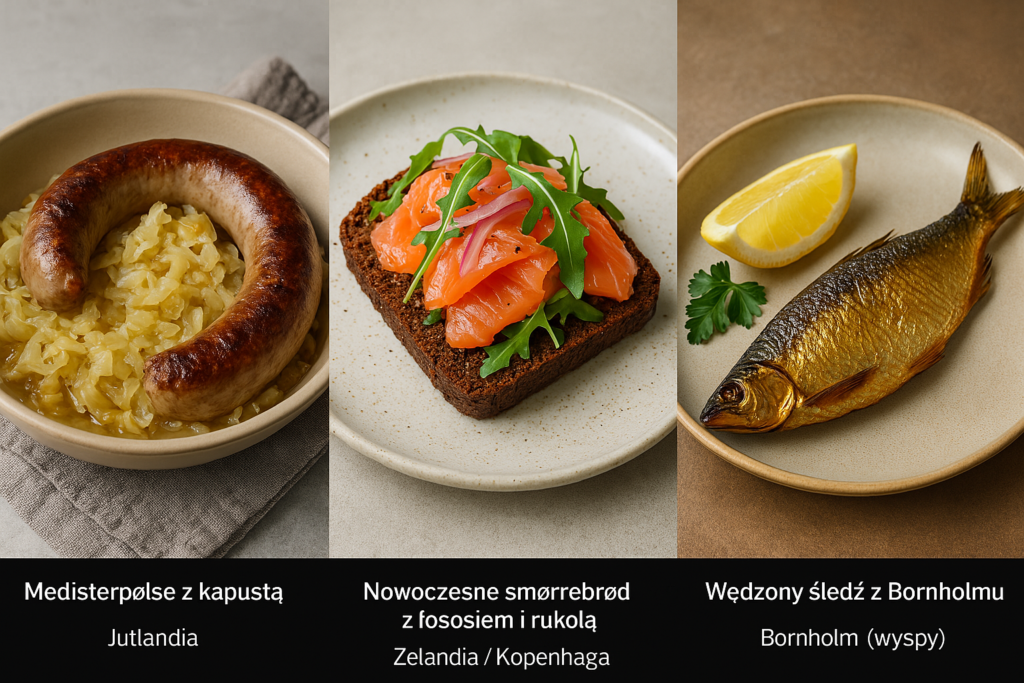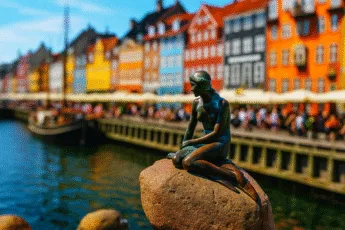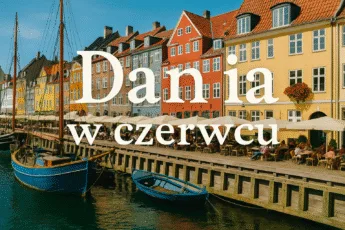Danish cuisine is not only Smørrebrød and meatballs. It is a fascinating combination of a harsh climate, Nordic tradition and a modern approach to cooking. Denmark, although small, has a whole range of flavors that will satisfy both carnivores and vegetarians. In this article you will find a full review of dishes, ingredients, customs and culinary curiosities that make Danish cuisine gain more and more recognition in the world.
Visiting Denmark - whether it is Copenhagen or peaceful towns of Jutland - it's worth knowing what to eat in Denmark to fully feel the taste of local culture. You will learn both traditional dishes and modern gastronomic trends . And all this served in the spirit of Danish hygge .
Danish cuisine - what makes it stand out and what is worth trying?
Danish cuisine is an example of how climate and history affect everyday food . It is dominated by local ingredients , simple cooking techniques and emphasis on the freshness of products. Danes have been using what nature gives them for generations: fish from cool seas, root vegetables, cereals, venison and milk.
In recent decades, the Movement of New Nordic Cuisine (New Nordic Cuisine) , initiated by chefs such as René Redziipi from the Noma , The goal was to combine tradition with modernity, seasonality with aesthetics. As a result, Denmark gained a world reputation as a center of culinary innovation .
At the same time, despite the presence of restaurants with Michelin stars home cooking plays a huge role in everyday life - simple but full of taste.
Smørrebrød - King of the Danish table
If you ask the average tourist, what he associates dishes with, the answer would probably be: Smørrebrød . This is a seemingly simple dish - an open sandwich on rye bread (rugbrød) - hides surprising diversity and culinary precision.
The basis is dark, sour bread that goes well with fish, meat, vegetables and sauces. Classic versions include:
- Follow in a marinade with onions and curry,
- Rosbef with roasted onion and remulage,
- hard -boiled egg with shrimps and dill,
- Baked bacon with red beetroot and mayonnaise.
The art of eating Smørrebrød is a separate topic - the Danes eat it with cutlery, with proper seriousness, often in a certain order (first fish, then meat). In many restaurants, Smørrebrød are served as small works of art - beautifully decorated, aesthetic and filling.
It's not just lunch - it's a cultural experience . And one of the most characteristic dishes of Danish cuisine.
Meat classics - Frikadeller, Steget Flæsk and others
Typical Danish dishes can not miss meat dishes. Although Denmark is famous for fish and seafood, meat plays an important role in the daily menu. If you are wondering what to eat in Denmark except sandwiches, here are some compulsory items.

Frikadeller - Danish meatballs
This is one of the largest classics-fried in a frying pan, slightly flattened meat meat meat , served with potatoes and red beetroot or stewed cabbage. Perfect for home -style dinner.
Steget Flæsk - a crunchy bacon with a parsley sauce
Officially considered a national dish of Denmark . These are thick slices of bacon fried to crunchiness, served with cooked potatoes and thick parsley sauce. Syme, greasy and absolutely delicious.
Medisterpølse - Danish sausage from the pan
Danish, slightly spicy pork sausage, often fried or stewed. Served with stewed cabbage and mustard-especially popular in the autumn and winter season.
All these dishes from Denmark can be found both at home and traditional restaurants. These are perfect examples of what Danish food is in the "Comfort Food" version .
Sample prices in Denmark (DKK)
| Dish | Typical ingredients | Price (average in the restaurant) |
|---|---|---|
| Frikadeller | Minced meat, onion, egg, spices | 95 DKK |
| Steget Flæsk | Bacon, potatoes, parsley sauce | 115 DKK |
| Medisterpølse | Pork sausage, cabbage, mustard | 98 DKK |
Fish and seafood in the kitchen of Denmark - what is worth trying?
Due to its geographical location, dishes have been based for centuries a large part of its kitchen on the gifts of the sea. If you are wondering what to eat in Denmark to feel the taste of real Scandinavia, you can not skip fish dishes . They are the foundation of traditional Danish dishes .
Follow in various versions
Herring is a real classic of Nordic cuisine. Danes serve it in many ways: in curry sauce, in vinegar, with onions, dill or mustard. It is often an element of Smørrebrød or an appetizer during holidays and celebrations.
Smoked salmon and gravlax
Smoked salmon is a luxurious but common position in Danish refrigerators. It is also served in elegant restaurants - with horseradish, egg, dill or on a sandwich. Gravlax, or salmon marinated in sugar, salt and dill, is a delicate and exquisite version of this fish.
Fiskesuppe - fish soup
Danish fish soup is usually based on white fish, vegetables (carrots, leeks, celery) and cream or milk. It is an aromatic and warming dish, especially popular in coastal regions.
Caloric content of selected fish dishes
| Dish | Typical ingredients | Calorie (portion 100g) |
|---|---|---|
| Herring marinated | Herring, onions, spices, cream | 220 kcal |
| Smoked salmon | Salmon, salt, smoke, spices | 180 kcal |
| Fiskesuppe (fish soup) | White fish, vegetables, cream, broth | 90 kcal |
Vegetables, potatoes and silage - Scandinavian additive
Although dishes can be associated mainly with fish and meat, vegetables - especially root - play a key role in the daily menu. The cold atmosphere and long winters have made the Danes learn to use what is available all year round - and this means a lot of potatoes, cabbage, onions or beets.
If you are wondering what to eat in Denmark except meat and fish, it is Danish silage and vegetable additions that are an integral part of traditional dishes. Their taste perfectly breaks the greasiness of the main ingredients.

Potatoes in every form
Cooked, baked, puree, with butter and dill - potatoes are the basis of many dishes from Denmark . Small, young potatoes served with parsley sauce are particularly popular (e.g. at Steget Flæsk ).
Silage and marinades
Danish cuisine abounds in sauer red cabbage (rødkål), beetroot, cucumbers and onions. Most often they are an addition to meat dishes and Smørrebrød sandwiches. They not only have taste, but also support digestion.
Cabbage - the queen of add -ons
In addition to silage, cabbage stewed with apples, cinnamon and vinegar is popular. This is a classic addition to dishes served especially at Christmas.
Regional origin of selected ingredients
| Product | Description | Region / origin |
|---|---|---|
| Young potatoes | Served with butter and dill, often with meat or fish | Zealand (Sjælland), Fiony |
| Rødkål (red braid cabbage) | With apples, vinegar, sugar - an addition to meat dishes | Whole dish |
| Pickled beets | Marinated with vinegar and sugar, often homemade | Jutland |
Danish desserts - the sweet side of Scandinavia
When you try Smørrebrød, Frikadeller and fish specialties, it's time for something sweet. Danish desserts are a combination of simplicity and homemade heat, often using milk, rice, cinnamon, vanilla and nuts. If you are wondering what to eat in Denmark for dessert , here are some obligatory items.

Risalamande - rice with almonds and cherries
This is a classic Christmas dessert based on rice cooked in milk, served with whipped cream, vanilla and cherry sauce. The almond is hidden inside - who finds it, gets a reward!
Drømmekage - "Dream Cake"
Sponge cake with coconut, slightly caramelized coating. He comes from the small town of Hjallerrup and is often served at family meetings.
Kanelsnegle - cinnamon snails
Popular not only in Denmark, but it is here that they reach the championship. Warm, fragrant cinnamon, with delicate icing - perfect for coffee. Often available in bakeries and at gas stations.
Caloric content of selected Danish desserts
| Dessert | Main ingredients | Calorie (portion 100g) |
|---|---|---|
| Risalamande | Rice, milk, cream, vanilla, cherries | 160 kcal |
| Drømmekage | Flour, sugar, eggs, coconut, butter | 350 kcal |
| Kanelsnegle | Yeast, flour, cinnamon, sugar, icing | 410 kcal |
Danish breakfast and daily culinary customs
For the Danes, breakfast is one of the most important meals of the day, although generally quite simple and practical. If you are wondering what the Danes eat every day , the answer is: a lot of bread, dairy products and local products. Hygge's lifestyle and culture also affect what Danish breakfast and other meals during the day look like.
Breakfast - simplicity and quality
Most often, it is dark rye-pass bread (rugbrød) with butter, cheese, jam, or a hard-boiled egg or a slice of sausages. Flakes with milk or yogurt and coffee - strong and black are also popular. On weekends you can also find fresh rolls (Rundstykker) from the bakery.
Lunch - Smørrebrød and something light
During the day, Danes often eat cold - e.g. Smørrebrød at work or salad. Lunch is usually a quick meal, but not without nutritional value. Danish schools and companies often offer the "Madpakke" option - that is, prepared at home or bought a work kit.
Dinner - the main meal
In the evening, families meet for a warm meal. It can be a dish with meat, fish, vegetables, potatoes - then more filling dishes are served. Dinner often ends with tea or a sweet snack.
Sample prices of popular breakfasts (DKK)
| Breakfast | Composition | Price (average in the cafe) |
|---|---|---|
| Rugbrød with butter and cheese | Rye bread, butter, cheese | 45-55 DKK |
| Buns with jam and coffee | Rundstykker, butter, jam, coffee | 65–75 DKK |
| Fruit porridge | Oatmeal, milk, seasonal fruit | 55–60 DKK |
Danish drinks: beer, Akvavit and more
In Danish culinary culture, there can be space for drinks. From the popular beer from Denmark , through herbal Akvavit , to traditional coffee - drinks accompany both daily meals and special occasions. If you are wondering what to drink in Denmark , here are the most important suggestions.
Beer - National Classic
The Danes are proud of brands such as Carlsberg and Tuborg , exported all over the world. Beer is an integral part of social gatherings, grills and lunch. Craft beers (microbrowers) are also becoming more and more popular, e.g. Mikkeller or Øl.
Akvavit - Scandinavian herb vodka
Akvavit is a high -percentage drink (40-45%), flavored with cumin, dill or other spices. Traditionally served chilled, often accompanies Christmas dishes or Smørrebrød.
Coffee - a daily ritual
The Danes belong to the top of the nations drinking the most coffee in the world. Black coffee, without milk, drunk is all day - at work, home, at a gas station. Scandinavian style cafes are also popular.
Alcohol content and caloric content of selected drinks
| Drink | Type / taste | Alcohol (%) | Calories (100 ml) |
|---|---|---|---|
| Carlsberg Pilsner | Light beer | 5% | 42 kcal |
| Akvavit | Herbal vodka | 40–45% | 250 kcal |
| Black coffee | Without milk, no sugar | 0% | 2 kcal |
Street food and food in the city in Denmark
Although dishes are associated with elegant restaurants and "new Nordic cuisine", Street Food in Denmark is going through its flourishing. Especially food in the city in Copenhagen attracts gourmets from around the world - and not only those with a thick wallet.
Danish Hot Dog - street legend
There is no more classic street dish than the Danish Hot Dog . Served with crunchy onion, canned cucumber, mayonnaise and remulage, it is available almost everywhere - from gas stations to food trucks.
Food hall and food fair
In large cities such as Copenhagen or Aarhus, you will find fashionable food halls - e.g. Reffen , Torvehallerne or Street Food Market . You can try dishes from around the world, as well as modern variations on the classics of Danish cuisine.
Kitchen fusion and veg options
Danish Street Food is also a plant , Asian, Mexican or Gourmet burger cuisine. Importantly, more and more premises offer vegan and gluten -free dishes, without giving up quality and taste.
Prices of popular street dishes (DKK)
| Dish | Description | Price (average) |
|---|---|---|
| Hot Danish | With onions, cucumber, remulage and mustard | 35–45 DKK |
| Burger Gourmet | Beef, butterburry, premium accessories | 75–95 DKK |
| Street Food plate (Reffen) | Fusion kitchen: tacos, curry, Korean bbq | 90-120 DKK |
Where to try? The best restaurants and premises
Although the Danish cuisine is available at almost every step, it is worth knowing where to eat in Copenhagen and other Denmark cities to try it at its best. From Christmas restaurants to traditional inn - everyone will find something for themselves.

Noma - culinary legend
Noma (Refshaleva 96, 1432 Copenhagen K) - repeatedly recognized as the best restaurant in the world, he specializes in a new Nordic cuisine . The tasting menu changes seasonally and is based on local ingredients. Reservations are necessary well in advance. noma.dk
Schønnemann - tradition of Smørrebrød
Restaurant Schønnemann (Hauser pl. 16, 1127 Copenhagen) serves one of the best Smørrebrød in Denmark. It is an ideal place for lunch in the climate of the old Copenhagen inn. restaurantschonnemann.dk
Reffen - Street Food and Craft Denmark
Reffen Copenhagen Street Food (Refshaleva 167, 1432 Copenhagen) - a modern food market with a view of water. The perfect place to try Danish dishes in the fusion version. Reffen.DK
Regions - what outside Copenhagen?
It is worth visiting cities such as Aarhus, Odense or Aalborg. Local taverns often serve typical Danish dishes at a very affordable price, with a homemade atmosphere and service.
Examples of premises and price range (DKK)
| Restaurant | Kitchen type | Price range (person) |
|---|---|---|
| Noma | New Nordic cuisine (fine dining) | 3000–4000 DKK |
| Schønnemann | Traditional Smørrebrød and Beer | 150–250 DKK |
| Refined | Street food / kitchen fusion | 90-150 DKK |
What to bring home from Denmark?
After a culinary journey around Denmark, it's hard to come back empty -handed. Danish food products and original delicacies are a great gift idea - both for yourself and loved ones. If you are wondering what to bring from Denmark , here are the most interesting proposals.
Danish cheese
Among them stands out Danbo , Havarti and more intense blue blue cheese, e.g. Blå Castello . Available in most supermarkets and at the airport.
Jams and jam
Danes love berries, rhubarb and strawberries. High -quality jam (e.g. Den Gamle Fabrik ) have a simple composition and intense taste.
Sweets - Lucretia and Marzipan
Salty licorice is popular in Denmark - a difficult but characteristic taste. Marzipan (e.g. from Anthon Berg ) is a classic for Christmas.
Akvavit or local beer
If you come back without luggage restrictions - it's worth taking a bottle of local alcohol. Akvavit is a iconic drink, and Danish craft beers often inaccessible outside the country.
Rugbrød and crunchy bread
Some bakeries offer packed dark rye breads that tolerate transport well. You can also buy ready -made mixtures for baking at home.
Popular products for bringing from Denmark
| Product | Description | Price (average) |
|---|---|---|
| Danbo cheese (250g) | Delicate semi -hard cheese, mild taste | 18–25 DKK |
| Den Gamle Fabrik jam (380g) | Natural ingredients, various flavors | 22-30 DKK |
| Chocolates Anthon Berg (150g) | Marzipan in chocolate, luxurious gift | 35-50 DKK |
Danish cuisine for vegetarians and vegans
Although traditional Danish cuisine is based mainly on fish, meat and dairy, in recent years there has been a huge development of the plant . In larger cities, especially in Copenhagen and Aarhus, you can easily find vegan food in Denmark and vegetarian versions of classics .
What to eat in Denmark without meat?
Many Danes reach for vegetable alternatives - both for health and climate reasons. Restaurants, food trucks and bakeries are increasingly offering veg and vegans. Lentils, groats, root vegetables and meat substitutes (soy, beans or peas) are popular.
Vegan versions of Smørrebrød
In many places you will find plant Smørrebrød - with avocado, hummus, roasted beets, marinated onions and vegetable pastes. Instead of butter, vegan margarines or legumes are used.
Vegan baked goods and coffee with vegetable milk
Danish cafes offer a wide selection of veg cakes (with banana, chocolate, rhubarb), and vegetable milk (oat, almond) is already a standard when ordering coffee.
Examples of vegetarian and vegan dishes
| Dish | Typical ingredients | Veg / vegan |
|---|---|---|
| Smørrebrød with hummus and beetroot | Rye bread, hummus, baked beets, rocket | Vegan |
| Veg lentil meatballs | Lentils, onions, spices, breadcrumbs | Vegetarian |
| Oatmeal with oat milk | Oatmeal, vegetable milk, fruit | Vegan |
Regional kitchen: Jutland, Zealand and Islands
Although Denmark is a small country, its culinary map is surprisingly diverse. Denmark's regional cuisine reflects local traditions, availability of ingredients and historical influences. If you want to know the culinary flavors deeper, it is worth paying attention to the differences between Jutland, Zealand and the Islands .

Jutland - classic and tradition
heavier dishes dominate : stewed cabbage, meatballs (frikadeller), medisterpøls and potatoes with sauce. Jutlanders are famous for its conservative approach to the kitchen - simplicity, satiety and locality counts.
Zealand - lightness and urban influences
Copenhagen is the heart of the new Nordic cuisine . In Zealand, we will more often meet light dishes, creative interpretations of classics and influence of world cuisine - from Asian to Mediterranean.
Islands - fish, seafood and freshness
Islands such as Bornholm offer unique flavors from the sea - fresh fish, smokehouse, local cheese and herbs. On the Islands, seasonality and contact with nature are important.
Examples of regional dishes in Denmark
| Dish | Description | Region |
|---|---|---|
| Medisterpølse with cabbage | Thick pork sausage with stewed cabbage | Jutland |
| Modern Smørrebrń with salmon and rocket | Interpretation of a classic fusion sandwich | Zealand / Copenhagen |
| Smoked herring from Bornholm | Traditionally smoked in local smokehouse | Bornholm (Islands) |
FAQ - the most frequently asked questions
Danish cuisine is much more than just food - it is part of the lifestyle, hygge and respect for local traditions. Regardless of whether you are a lover of meat, fish, desserts or veg option - in Denmark everyone will find something for themselves .
We hope that this guide will help you better understand what to eat in Denmark , how Danish everyday life tastes and where to look for the best local dishes.














